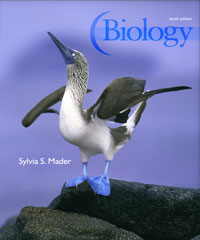Biology (Mader), 10th EditionChapter 28:
Invertebrate EvolutionLearning OutcomesAfter studying this chapter, you should be able to accomplish the following outcomes.
Evolution of Animals - Describe the characteristics that separate the animal phyla from other phyla of living organisms.
- Discuss the "colonial flagellate hypothesis" as it relates to the evolution of animals.
- Explain the data used to develop the animal phylogenetic tree.
- Distinguish between protostomes and deuterostomes.
Introducing Invertebrates- Describe the sponges.
- Describe the comb jellies.
- List examples of cnidarians.
- Discuss the specializations unique to cnidarians.
Variety among the Lophotrochozoans- Explain the characteristics that unite the lophotrochozoans and list the animal phyla that fit into this group.
- List the characteristics of members of phylum Platyhelminthes.
- Distinguish between the free-living flatworms and the parasitic flatworms.
- Describe rotifers.
- Discuss the characteristics of mollusks.
- List and describe examples of the major groups within phylum Mollusca.
- Describe the major characteristics of annelids.
- Distinguish between the major groups of annelids.
Quantity among the Ecdysozoans- Explain the characteristics that unite the ecdysozoans and list the animal phyla that fit into this group.
- List and describe examples of roundworms and their effects on humans.
- Discuss the five characteristics credited for the success of arthropods.
- Give examples of the major groups of arthropods and describe their specializations.
Invertebrate Deuterostomes- Describe the characteristics of echinoderms.
- List examples of the major groups of echinoderms.
- Discuss the adaptations of sea stars and how they relate to the characteristics of echinoderms in general.
 | 




